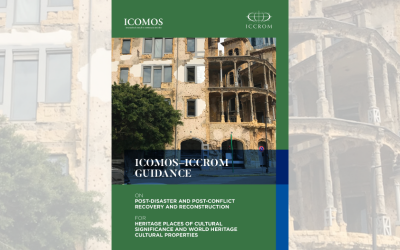New ICOMOS-ICCROM Guidance on Post-Disaster and Post-Conflict Recovery and Reconstruction

This new publication by ICOMOS and ICCROM, 'Guidance on Post-Disaster and Post-Conflict Recovery and Reconstruction for Heritage Places of Cultural Significance and World Heritage Cultural Properties' is intended for experts working in heritage conservation and provides a framework through which the recovery of heritage places can be supported and harnessed in coming to terms with and overcoming the trauma associated with destruction and loss.
Origin of the guidance: an 8-year process
In 2015 the World Heritage Committee emphasised the importance of ‘a post-conflict strategy for reconstruction of damaged World Heritage’. The means to be considered would include technical assistance, capacity-building, and the exchange of good conservation and management practices. In 2016 the Committee tasked the Advisory Bodies with developing guidance on the reconstruction of such properties. A range of initiatives has emerged to address different aspects of the challenges posed.
This Guidance document builds on the initiatives of ICOMOS and ICCROM and those of other bodies, and extends the collaboration of the ICOMOS–ICCROM Project ‘Analysis of Case Studies in Recovery and Reconstruction’, published in 2021. It provides a framework through which the recovery of heritage places can be supported and harnessed in coming to terms with and overcoming the trauma associated with destruction and loss.
Aim and target audience
This Guidance aims to help relevant actors affected by destruction at heritage places of cultural significance to set up sound decision-making processes for recovery and reconstruction. It sets out a framework within which thorough, informed and participative decision-making can be undertaken in recovery. Recovery is understood to include reconstruction, involving tangible and intangible attributes of heritage places and World Heritage properties. The Guidance aims to suggest a context-attentive recovery approach that enables the perpetuation of the significance of heritage places and Outstanding Universal Value (OUV) of World Heritage properties to the greatest extent possible.
The document is primarily addressed to experts working in heritage conservation and all those with responsibility for the protection and conservation of the heritage place on the ground. In the World Heritage context, it is addressed to States Parties, their relevant authorities and implementing agencies, and technical staff in the relevant sectors. It may also assist a wide range of community actors, including civil society, in organising responses to catastrophe and recovery.
![]() Read the press release in English / Arabic
Read the press release in English / Arabic
See more
![]() ICOMOS-ICCROM Analysis of Case Studies in Recovery and Reconstruction / Volume 1 (2020)
ICOMOS-ICCROM Analysis of Case Studies in Recovery and Reconstruction / Volume 1 (2020)
![]() ICOMOS-ICCROM Analysis of Case Studies in Recovery and Reconstruction / Volume 2 (2020)
ICOMOS-ICCROM Analysis of Case Studies in Recovery and Reconstruction / Volume 2 (2020)
![]() ICOMOS-ICCROM Analysis of Case Studies in Recovery and Reconstruction / Report / Volume 3 (2020)
ICOMOS-ICCROM Analysis of Case Studies in Recovery and Reconstruction / Report / Volume 3 (2020)
